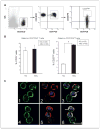Increased frequency and suppression by regulatory T cells in patients with acute myelogenous leukemia
- PMID: 19417016
- PMCID: PMC3700356
- DOI: 10.1158/1078-0432.CCR-08-3010
Increased frequency and suppression by regulatory T cells in patients with acute myelogenous leukemia
Abstract
Purpose: Regulatory CD4(+)CD25(high)Foxp3(+) T cells (Treg) control peripheral immune tolerance. Patients with cancer, including those with hematologic malignancies, have elevated numbers of Treg in the peripheral circulation and in tumor tissues. However, mechanisms of suppression and clinical significance of Treg, especially in patients with acute myelogenous leukemia (AML), has not been well defined.
Experimental design: We prospectively evaluated the phenotype, function, and mechanisms of suppression used by Treg in newly diagnosed untreated AML patients. The relationship between the frequency of circulating Treg and the disease status as well as treatment outcome was also evaluated.
Results: The percentage of circulating Treg was higher (P < 0.0001) and their phenotype was distinct in AML patients relative to normal controls. Suppression mediated by Treg coincubated with proliferating autologous responder cells was also higher (P < 0.001) in AML than that mediated by control Treg. Using Transwell inserts, we showed that interleukin-10 and transforming growth factor-beta1 production as well as cell-to-cell contact were necessary for Treg-mediated suppression. Also, the pretreatment Treg frequency predicted response to chemotherapy. Unexpectedly, patients who achieved complete remission still had elevated frequency of Treg, which mediated high levels of suppressor activity.
Conclusions: Treg accumulating in the peripheral circulation of AML patients mediate vigorous suppression via contact-dependent and contact-independent mechanisms. Patients with lower Treg frequency at diagnosis have a better response to induction chemotherapy. During the post-induction period, the Treg frequency and suppressive activity remain elevated in complete remission, suggesting that Treg are resistant to conventional chemotherapy.
Conflict of interest statement
No potential conflicts of interest were disclosed.
Figures






References
-
- Ferrone S, Whiteside TL. Tumor microenvironment and immune escape. Surg Oncol Clin N Am. 2007;16:755–74. viii. - PubMed
-
- Whiteside TL. Immune suppression in cancer: effects on immune cells, mechanisms and future therapeutic intervention. Semin Cancer Biol. 2006;16:3–15. - PubMed
-
- Sakaguchi S. Naturally arising CD4+ regulatory T cells for immunologic self-tolerance and negative control of immune responses. Annu Rev Immunol. 2004;22:531–62. - PubMed
-
- Hori S, Nomura T, Sakaguchi S. Control of regulatory T cell development by the transcription factor Foxp3. Science. 2003;299:1057–61. - PubMed
-
- Sakaguchi S. Naturally arising Foxp3-expressing CD25+CD4+ regulatory T cells in immunological tolerance to self and non-self. Nat Immunol. 2005;6:345–52. - PubMed
Publication types
MeSH terms
Substances
Grants and funding
LinkOut - more resources
Full Text Sources
Other Literature Sources
Medical
Research Materials

